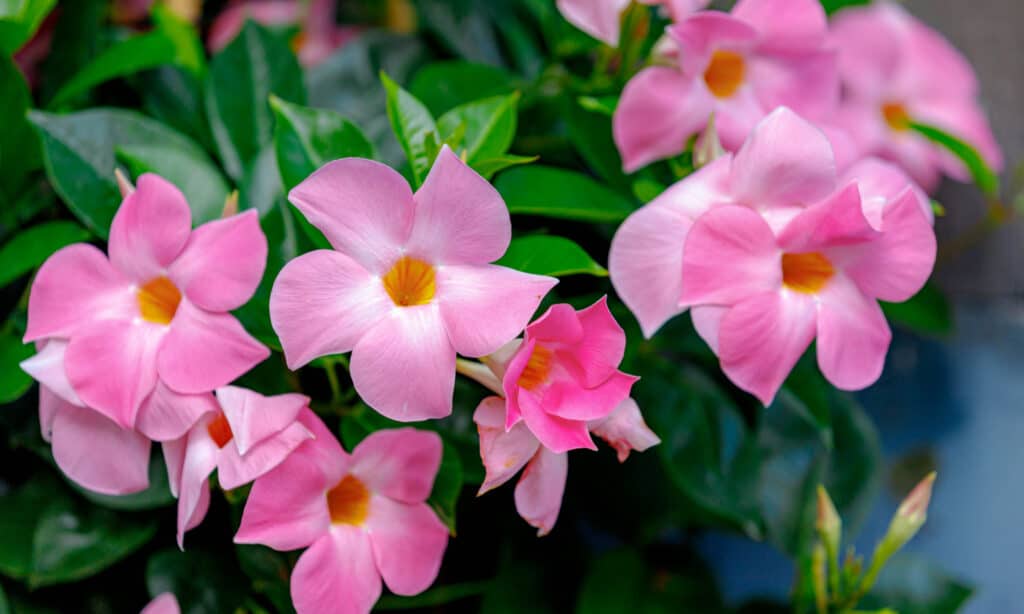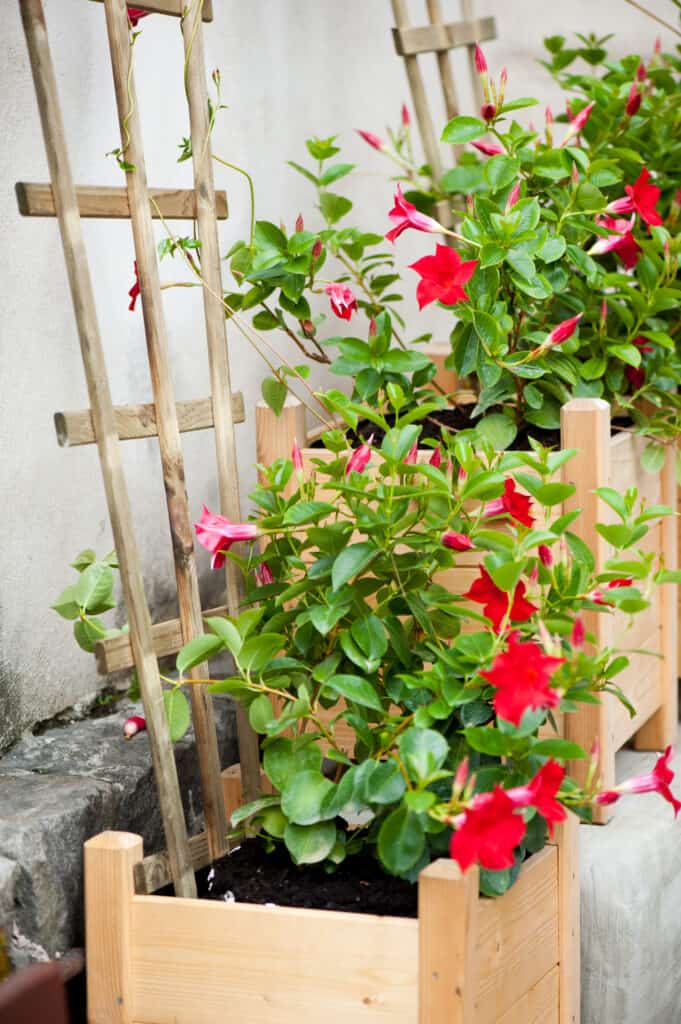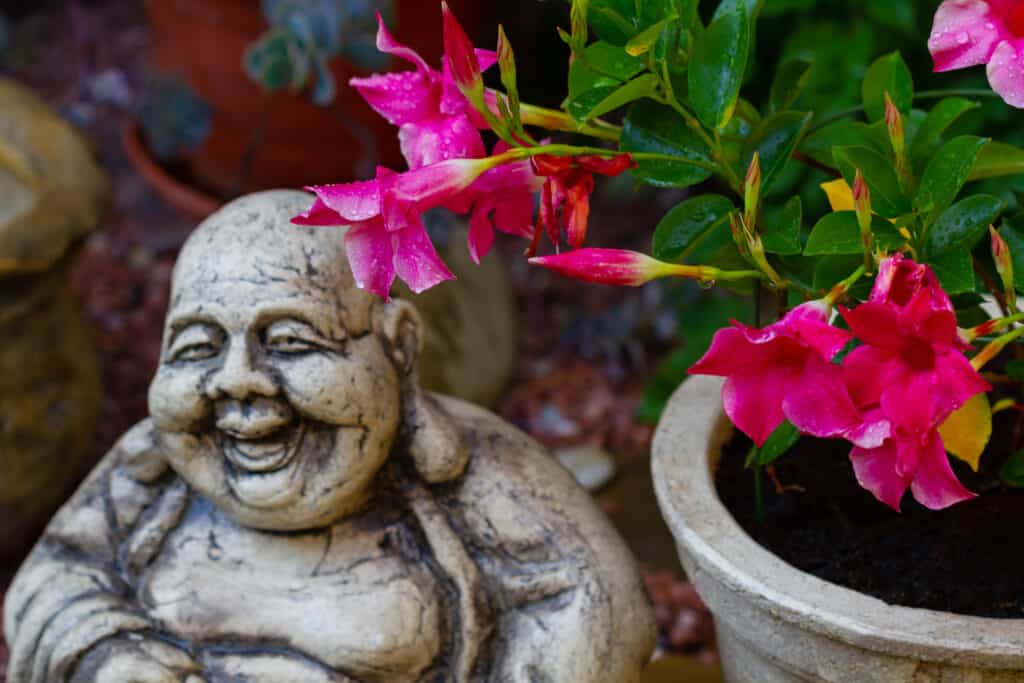Mandevilla is a rock trumpet and a flowering vine of stunning color. It’s a tropical plant with glossy green foliage, but is mandevilla a perennial or annual? It all depends on the growing zone.
Mandevilla: Perennial or Annual
Mandevilla is naturally perennial and in tropical or sub-tropical zones it will grow back each year. In cold zones, it’s grown as an annual because cold temperatures kill it each winter. This is what makes some gardeners think mandevilla is an annual plant.
What Is Mandevilla?
Mandevilla is a beautifully fragrant and brightly colored climbing vine from tropical and subtropical regions of Brazil, Mexico, and the West Indies. It’s a member of the Apocynaceae family (there are over 200 species in this family) and was named after the British Victorian-era diplomat Henry Mandeville who discovered it in Argentina in the early 1800s.
Mandevilla has a trumpet-shaped flower with five petals hence its common name rock trumpet. It’s one of the most colorful flowering vines around with summer blooms of red, pink, or white depending on the species or cultivar.
Its color can vary, but all perennial mandevilla vines have trumpet-shaped flowers. They’ve evolved this way so hummingbirds and long-tongued bees can reach inside.
Throughout history, Mandevilla has been used as medicine. In Brazil, a subspecies of Mandevilla called velame was used to treat inflammation and today it’s investigated for its potential cardiovascular properties.

Mandevilla has trumpet-shaped flowers with five petals
©Nahhana/Shutterstock.com
What Species Should I Grow?
Alongside the native species, there are hundreds of hybrids too!
Here are some of the most popular Mandevilla species:
- M. sanderi: Brazilian jasmine 15 feet tall with large pink flowers
- M. laxa: Chilean jasmine 20 feet tall fragrant white flowers
- M. boliviensis: White Mandevilla 10 feet tall with small white flowers
- M. × amabilis: Alice du Pont. Most likely a 19th-century hybrid. Pink with yellow throat grows to 5 feet.

The Dipladenia is similar to Mandevilla but is a smaller, bushier plant.
©Wut_Moppie/Shutterstock.com
Are Mandevilla and Dipladenia The Same?
Not quite! Dipladenia is a sub-species of Mandevilla. They look very similar and are often assumed to be the same plant. However, the difference is that Dipladenia is a smaller, bushier plant with wide glossy smooth leaves that prefer to grow hanging down. Mandevilla is a vertical climber with thinner leaves.
Confusingly they are both called rock trumpets! Both Dipladenia and Mandevilla are perennial, not annual in warm climates.
What Does Perennial Plant Mean?
Perennial plants live for more than two years. They can be evergreen or deciduous. The deciduous plant loses its foliage in winter and dies back to a root ball to survive the cold temperatures. Annual plants are ones that complete their lifecycle in one year. Annuals germinate, flower, set seeds, and die within the spring to autumn months.
Mandevilla is a perennial plant that will grow all year round in tropical climates but dies if the temperature gets too cold.
Does Mandevilla Come Back Each Year?
In tropical countries and US zones, 9-11 Mandevilla comes back each year. Northern climates are too cold for this tropical beauty to survive. Any area that experiences frost will need its Mandevilla replaced each year or existing plants should be brought indoors.
How To Keep Mandevilla Over Winter
Any Mandevilla growing in zones 8 and under will need winter care. Mandevilla are not frost tolerant and they don’t cope well with cold wind or consistent cold and wet soil. The best option in northern areas is to bring Mandevilla inside.
How Long Does Mandevillas Last?
In their natural tropical or subtropical habitats, Mandevilla plants live for many years and they bloom from late spring to October without a break. They are hard-working plants!
Will Mandevilla Come Back After A Freeze?
Probably not. Mandevilla are tropical vines and whilst they can tolerate sunshine and heat, they can’t cope with minus temperatures. Anything much below 50 degrees will usually spell the end for Mandevilla.
How To Prune Mandevilla
These glorious tropical vines are usually grown on a trellis or fence line, so they need pruning to keep their size manageable. Mandevilla bloom on new growth, so pruning encourages profuse flowering too. It’s worth taking the time to do it properly.
In early spring before any new growth appears, trim back untidy excess growth. Aim to remove no more than a third and cut just above a set of leaves. It’s important to water and fertilize it afterward to avoid stressing the plant.

Mandevilla can be grown on a trellis or fence line.
©Ariene Studio/Shutterstock.com
Do Hummingbirds Like Mandevilla
Yes, hummingbirds, butterflies, and bees all love Mandevilla’s large trumpet-shaped flowers. Encourage them by planting a Mandevilla in an undisturbed sunny spot.
How To Deadhead Mandevilla
Deadheading the majority of plants through their blooming season encourages new fresh flowers. This is because flowers are the forerunner to seeds, and all plants are trying to reproduce. If you remove spent flowerheads, the plant will generate more in an attempt to set seeds.
Simply pinch off dead flowers between your thumb and forefinger. Be careful not to pinch the vine and keep an eye out for bees!
Is Mandevilla Poisonous To Pets?
The ASPCA doesn’t list Mandevilla as poisonous for pets, but it’s never a good idea to let pets chew garden plants.
Why Won’t My Mandevilla Flower?
The most common reason Mandevilla won’t flower is lack of light. It’s a tropical plant that needs 6-8 hours of light and warmth each day. Another issue might be poor pruning. Because it flowers on new growth, pruning Mandevilla in late spring or early summer removes all the flowering buds.
If neither of these solutions fixes the issue, try fertilizing and watering more frequently – but be sure there’s ample drainage. Mandevilla does not like soggy feet!

If your Mandevilla isn’t flowering, try giving it more water.
©Photo_Olivia/Shutterstock.com
Which Mandevilla Is Perennial?
All Mandevilla are perennial, not annual if they are grown in tropical climates or zones 9-11. If you live in the north or below zone 8 cut your vine down in early autumn and bring it indoors for warmth. It can head back outside once all risk of frost has passed. Many gardeners choose to grow Mandevilla in a container so it’s easier to bring inside.
Sources:
https://www.rhs.org.uk/plants/mandevilla/growing-guide
https://www.science.gov/topicpages/m/mandevilla+velutina+apocynaceae
https://www.aspca.org/pet-care/animal-poison-control/toxic-and-non-toxic-plants
Up Next
The photo featured at the top of this post is © pixel creator/Shutterstock.com
Sources
Thank you for reading! Have some feedback for us? Contact the AZ Animals editorial team.







